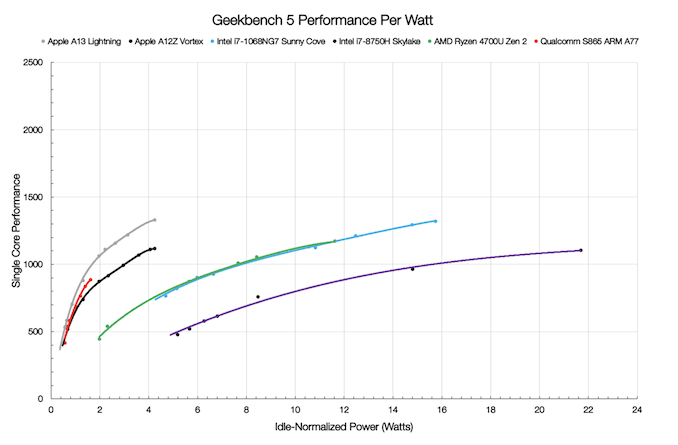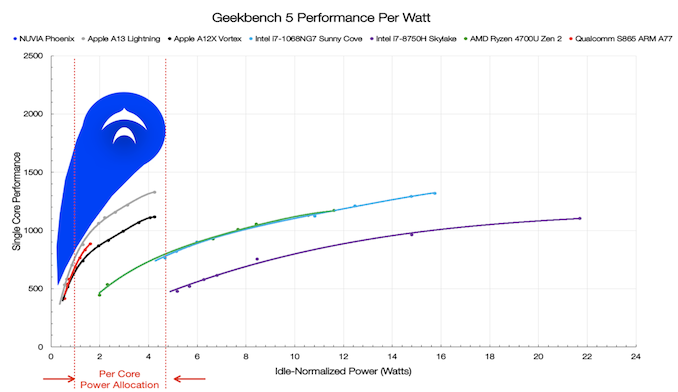NUVIA Phoenix Targets +40-50% ST Performance Over Zen 2 for Only 33% the Power
by Dr. Ian Cutress on August 11, 2020 1:00 PM EST
In November 2019, the company NUVIA broke out of stealth mode. Founded by former senior Apple and Google processor architects, John Bruno, Manu Gulati and Gerard Williams III, the company came crashing out of the gate with quite considerable goals to revamp the server market with an SoC that would provide ‘A step-function increase in compute performance and power efficiency’. Today NUVIA is putting more data behind those goals.
The press release we received from NUVIA takes some time to cover some of the basics of the modern day server market, and it initially read almost like an AnandTech article, which is eerily scary. Suffice to say, NUVIA understands the current state of play of the server market, including where Intel and AMD stand with respect to each other, and how x86 offerings are squaring up against the other options on the market. As with most elements of the server market, different verticals often have different requirements, on compute, memory, IO, power, or physical constraints, as well as initial cost of hardware alongside total cost of ownership. To that end, NUVIA’s processor designs, according to the company, ‘an SoC that will deliver industry-leading performance with the highest levels of efficiency, at the same time’.
With that, NUVIA is announcing that its first generation CPU core will be called Phoenix and be built upon the ARM architecture (likely Armv9) with an architecture license. Phoenix will be part of the Orion SoC, with NUVIA stating that they are implementing ‘a complete overhaul of the CPU pipeline’. Gerard William’s designs from Apple are known to be considerably different to what we’ve seen elsewhere in the market, so we suspect that this is going to be a big part of the secret sauce behind Orion and its Phoenix cores.
NUVIA goes on to say that Phoenix is ‘a clean sheet design’, focusing on single core performance leadership and maximizing memory bandwidth and utilization. The Orion SoC will be built to focus on high utilization and sustained frequencies, without having to rely on high-turbo marketing numbers, to allow customers to make the best use of the hardware within allocated power and cooling budgets. Alongside this, NUVIA is stating that there will be hardware infrastructure built to specification ‘to support peak performance on real cloud workloads’.
NUVIA’s Numbers
The big part of the press release is NUVIA’s performance-per-watt claims. To do this, NUVIA is using Geekbench5 as a performance indicator, along with direct power measuring, of current in-market x86 and Arm offerings. NUVIA is taking smartphone and mobile based cores, such as Intel Ice Lake, Qualcomm SD865, AMD Ryzen 4700U, as well as Apple’s A12Z Vortex and A13 Lightning, as starting points. The reason for this is that NUVIA believes there is starting to become no meaningful difference between smartphone/mobile cores and server cores when extrapolated – only if you start adding in massive vector engines for specific customers does that become relevant.
According to NUVIA’s numbers, this is where the current market stands with respect to Geekbench 5. At every point, ARM’s results are more power efficient/higher performant than anything available on x86, even though at the high end Apple and Intel are almost equal on performance (for 4x the power on Intel).
NUVIA notes that power of the x86 cores can vary, from 3W to 20W per core depending on the workload, however in the sub 5W bracket, nothing from x86 can come close to the power efficiency of high-performance Arm designs. This is where Phoenix comes in.
NUVIA’s claim is that the Phoenix core is set to offer from +50% to +100% peak performance of the other cores, either for the same power as other Arm cores or for a third of the power of x86 cores. NUVIA’s wording for this graph includes the phrase ‘we have left the upper part of the curve out to fully disclose at a later date’, indicating that they likely intend for Phoenix cores to go beyond 5W per core.
At this point, NUVIA is running simulations of its core designs in-house to get these numbers. This is a standard thing for any company developing a new SoC or a new core before actually going to the fab to get it made. It also helps investors analyze where things stand.
What gives credibility to the new company’s lofty goals is the founder’s track record of their past designs. Apple’s silicon success over the last half decade has been one of the most impressive developments in the industry, and it seems NUVIA has been able to recruit top talent with the aim to reproduce such success in the datacentre market.
Some users might consider that SPEC should have been used, given its relevance to NUVIA’s initial target markets on server, and I perhaps agree. I suspect that NUVIA believed that GB5 might be more accessible to a wider audience for core-to-core comparisons.
The Future
NUVIA states with this press release that it will aim to have some of the highest performance and best efficiency CPU/SoC products in the market. The company reiterates that even if other vendors suddenly see a 20% year-over-year gain in raw performance, NUVIA still expects to be ahead of its main competitors. We shall have to wait and see what magic NUVIA has that others do not.
Update: Initially this article said that NUVIA will have new products in the next 18 months. This was a simple misreading of NUVIA's press release and the relevent sentence has been removed.












43 Comments
View All Comments
name99 - Tuesday, August 11, 2020 - link
Oh give me a break. Amazon, Ampere, Marvell have all managed to scale their cores to 64, 80, 96 core SoCs. And they run those cores at <~3W each.What exactly do you imagine is so difficult about scaling up that Apple and Nuvia (both with extreme competence in the far harder task of designing a performant single-threaded CPU) will face difficulty?
The main thing your comment reveals is not Nuvia dishonesty but your ignorance.
Flunk - Monday, August 17, 2020 - link
That's not a good comparison, you're comparing chips designed for phones to ones designed for data centers. Ampere makes a 80-core ARM CPU that's a better comparison. There is no reason think Nuvia will be launching 4 core parts. Because ARM is a RISC architecture it doesn't need the more complex decoding hardware that an x86 CPU does so there is no reason to assume these CPUs will have un unccompetitve number of cores.MonkeyPaw - Tuesday, August 11, 2020 - link
I’m curious what AMD and Intel think of the graphs. Reading their blog, they admit that they can’t perfectly isolate the single core power from competing products. Their graph of the 4700U shows one core reaching close to 12W max, which is 80% of the chip’s TDP. Maybe it’s possible, but the entire chip is a 15W part and has 8 cores, a memory controller, and an IGP.As for if they get there—they aren’t Apple or AMD or Intel. Apple alone has serious cash to throw major resources at this. I don’t know how big NUVIA is, but they do appear to have venture capitalists backing them. That can be some high-stakes survival. I hope they can pull it off for the sake of competition.
NextGen_Gamer - Tuesday, August 11, 2020 - link
@ MonkeyPaw - This is looking at single-core performance only, in which case, for AMD & Intel the single-core can go up to and beyond the TDP. As you stated, AMD is more honest about their TDP then Intel, so it looks like a single "Zen 2" core can hit about 12-watts of the 15-watt total (the rest being things like the IGP, memory controller, etc.). Once more cores are utilized, that wattage would go down along with clockspeeds, hence why single-core peak turbo is different from all-core turbo.For Intel, it looks like they allow a single "Sunny Cove" core to ramp right up to & a tiny bit past the entire 15-Watt package TDP, which means that the total platform package is of course above that. It looks like though that is the only way Intel is still beating AMD on single-core pf, because up to that 12-ish watts, AMD is still slightly ahead.
Spunjji - Wednesday, August 12, 2020 - link
Just chiming in to note that I read this graph in the same way you did. Ice Lake is a 25W design part scaled back to 15W, and most of the released products reflect that basic design.anonomouse - Wednesday, August 12, 2020 - link
Worth noting that at the peak perf point, all 3 of Renoir, Ice Lake, and the Skylake are at 4.1Ghz, and within 100mhz of each other at the bottom. So the difference between the perf of Renoir and Ice Lake is primarily IPC, and this makes it even more interesting that they're riding essential the same curve.The other interesting aspect is that Skylake and Renoir have very basically the same perf/frequency scaling, but the obvious differences in the power curve demonstrate both how much more power 14nm Skylake burns at the same frequency/perf/IPC and how much harder Intel is pushing 14nm to scale the frequency at the top (see how the power gap widens considerably).
name99 - Tuesday, August 11, 2020 - link
The Nuvia point is basically- when you buy your Intel part, Intel makes a big deal about 5.5GHz (or whatever it is) BUT
- you only get that top frequency for a few seconds
- on only one core.
Nuvia believes (and I agree) that this obsession with peak frequency is idiotic and ruins every aspect of the chip design. (I've explained why elsewhere.) What they will sell you is a chip that runs all cores at peak performance all the time, not a marketing gimmick.
So, yes, you won't be able to goose the core from 3W normal power to 65W peak normal power under weird rare circumstances. In return, you'll get predictable performance, and a CPU upgrade every year or two rather than Intel's design machine that's ground to a halt because of the complexity of the circuits it's trying to design, coupled with a design flow that's unable to be too automated...
name99 - Tuesday, August 11, 2020 - link
If the US isn't willing to bankroll them, I suspect China will be more than happy to...PeachNCream - Tuesday, August 11, 2020 - link
It's always good to have another competitor in a market where there are far too few participants, but until a finished or nearly finished product is available for third party testing, there is nothing much to say.andrewaggb - Tuesday, August 11, 2020 - link
It would be great if they can release something that lives up to their claims in a timeframe that's relevant. The graphs are pretty meaningless until we can verify them ourselves. That said... if they can legit can improve IPC by 50% for mixed/general workloads that's pretty huge. Apple's been heading that way but seems unwilling to sell CPU's to the general market.